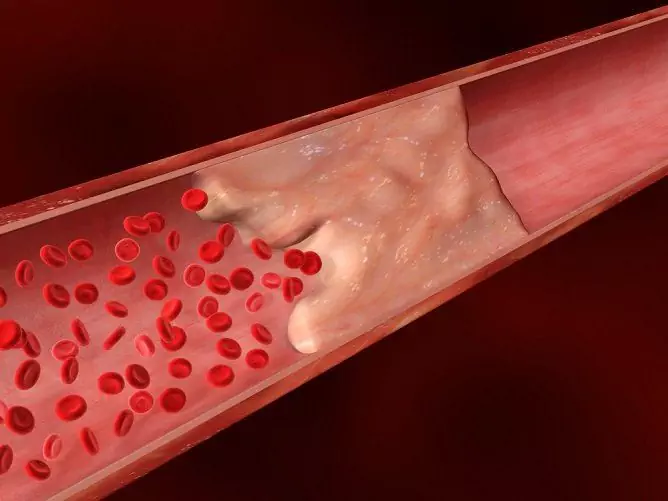Embolism
The content of the article:
- Forms of the disease
- Causes and risk factors
- Embolism symptoms
- Diagnostics
- Treatment
- Possible complications and consequences of embolism
- Forecast
- Prevention
Embolism is the circulation in the blood (or lymph) of particles not found in normal conditions and their blockage of blood vessels.
Blockage of blood vessels can occur as a formed thrombus, as well as a foreign body and a substance foreign to the body. In such situations, normal blood circulation is disturbed, tissues and organs stop receiving oxygen and necessary substances in sufficient volume.

Source: serdcemed.ru
Forms of the disease
The classification of emboli is based on the type of embolus and its final localization after the cessation of migration.
Emboli carried by the venous system enter the heart and from there into the lungs. Emboli carried by arteries can block vessels in different parts of the body.
By the origin of the embolus, the following types of embolism are distinguished:
- thromboembolism - emboli are blood clots of arteries, veins and heart;
- air and gas - blockage of blood vessels when air enters the veins or from bubbles of blood gases;
- fatty - fat cells act as emboli;
- tissue, or cell embolism - pieces of tissue or cell complexes act as emboli;
- fluid embolism - blockage by amniotic fluid;
- bacterial embolism - blockage of blood vessels by accumulations of microbes;
- embolism by foreign bodies.
The most common are thromboembolism, fat, air and gas embolism.
Thromboembolism - the most common type of embolism, occurs when a blood clot breaks off, gets into the circulating blood and clogs a blood vessel with it. If vein thrombi that form on the valves of the left heart valves, in the aneurysm of the heart, in the auricle of the left atrium, in the aorta and other arteries become emboli, then the blood flow in the vessel stops, thromboembolic syndrome with ischemic infarction develops. If the source of thromboembolism is blood clots in the chambers of the right half of the heart or the veins of the systemic circulation, then they fall into the branches of the pulmonary artery system. In this case, spasms of the bronchial tree, coronary arteries of the heart, branches of the pulmonary artery are observed. As a result of the blockage of its small branches, hemorrhagic infarction of the lung develops, the defeat of the large branches can be fatal.
With fatty embolism, the venous bed is blocked by drops of fat from destroyed or melted fat cells of the body. This becomes possible with extensive damage and trauma. Sometimes fatty embolism occurs with the intravenous administration of fatty solutions or preparations prepared in oil that are not intended for intravenous injection. Once in the arterial bed, fat drops do not dissolve in the blood, but accumulate in certain places. If the size of such an accumulation exceeds the diameter of the vessel (6-8 microns), blood flow is disturbed. Fat embolism affects the small capillaries of the lungs and brain. It can be subacute, acute (develops in the first hours after injury) and fulminant form (sudden death occurs within a few minutes).
Air-gas embolism occurs when the lumen of the arterial vessels of the pulmonary circulation is blocked by bubbles of air or other gas, which accumulate in the cavity of the right heart and stretch it. If large veins are damaged, air can enter them, then air bubbles with blood flow into the heart and are carried to all arterial basins. Even a small amount of air entering the peripheral veins can be fatal.
In the origin of gas embolism, the main role is played by sudden changes in atmospheric pressure (decompression sickness, which develops during immersion and rapid rise from the water), due to which undissolved gas bubbles block small arterial vessels without violating their integrity.
Causes and risk factors
Each of the types of embolism has its own reasons.
The reasons for the development of vascular thromboembolism:
- myocardial infarction;
- heart rhythm disturbances, atrial fibrillation;
- left ventricular aneurysm;
- operations on the pelvic organs, abdominal cavity and limbs, amputation of limbs;
- high cholesterol levels;
- hypercoagulation of blood;
- endocarditis;
- lung disease;
- rheumatism;
- diabetes;
- oncological diseases;
- diseases of the venous system of the pelvis and extremities (varicose veins, thrombophlebitis, post-thrombophlebitic syndrome);
- hypertension.
Reasons for the development of fatty embolism:
- massive skeletal injuries, fractures of the upper or lower extremities;
- extensive soft tissue injuries;
- fatty degeneration of the liver;
- bone marrow biopsy;
- intravenous injections of liposoluble preparations containing fatty elements that are not intended for this;
- severe burns;
- severe pancreatic necrosis;
- long-term corticosteroid therapy;
- osteomyelitis.
The reasons for the development of air and gas embolism:
- decompression sickness;
- trauma to large veins;
- gas gangrene;
- lung function abnormalities;
- gross violations of the technique of infusion therapy, non-compliance with the rules of vein catheterization, puncture;
- tissue damage during gynecological operations in violation of their technique;
- tissue damage during difficult labor.
The main risk factor is long-term immobility of patients after surgery in the lower extremities, after injuries. The risk group includes all bedridden patients, people forced to lead a sedentary lifestyle, patients with heart failure. Also, risk factors include taking certain medications (chemotherapy, hormone replacement therapy, use of hormonal contraceptives).
Embolism symptoms
Embolism symptoms depend on the location of the embolus.
Thromboembolism is manifested by hemodynamic disorders:
- chest pain;
- shortness of breath and rapid breathing;
- drop in blood pressure
- tachycardia;
- arrhythmia;
- sweating;
- tachypnea;
- coughing up blood.
The severity of symptoms of thromboembolism varies from almost complete absence of them to rapidly developing acute pulmonary heart failure.

Source: stopvarikoze.ru
The main manifestations of fat embolism:
- dysfunctions of the central nervous system (disorders of consciousness and psyche, attacks of severe headache, motor restlessness, “floating” eyeballs, delirium, delirium, meningeal symptoms, pyramidal insufficiency, paresis, paralysis, coma);
- signs of acute respiratory distress syndrome, acute respiratory failure, hyperthermia, chest pain, shortness of breath, apnea, cough with bloody sputum, tachycardia, tachyarrhythmias;
- petechial rashes on the cheeks, on the skin of the neck, chest, back, in the armpit;
- oliguria;
- hemorrhages in the oral mucosa, membranes of the eyes and conjunctiva.

Source: cardiobook.ru
The main manifestations of air and gas embolism:
- arterial hypotension;
- swelling of the neck veins;
- tachycardia;
- increased central venous pressure;
- chest pain;
- dyspnea;
- bronchospasm of unknown origin;
- motor excitement;
- disturbance of consciousness, fear of death.

Source: orlandohyperbarics.com
Diagnostics
To diagnose embolism, a comprehensive examination is prescribed: it is important not only to establish an accurate diagnosis, but also to find out the nature and cause of the embolism.
Diagnosis of thromboembolism is based primarily on the use of computed tomography (CT), the method allows you to determine the presence of a blood clot in the pulmonary vessels. Other diagnostic methods are also used (ventilation-perfusion scintigraphy, venous compression ultrasonography, pulmonary angiography), which are of secondary importance.

Source: cardiobook.ru
In case of fat embolism, laboratory tests can reveal:
- a decrease in the oxygen content in the blood;
- decrease in hemoglobin levels;
- a decrease in the number of platelets, a decrease in the level of fibrinogen;
- presence of neutral fat in urine, blood, sputum, cerebrospinal fluid;
- the presence of fatty retinal angiopathy;
- the presence of fat on skin biopsy in the area of petechiae.
Instrumental studies (MRI, CT) allow to establish the origin of the embolism, radiography of the lungs allows to exclude or confirm pneumothorax, the presence of acute respiratory distress syndrome. Monitoring using pulse oximetry, control of intracranial pressure is also used.
Air embolism is diagnosed using the following methods:
- capnogram - a non-invasive method for measuring and recording carbon dioxide levels during the respiratory cycle;
- the study of blood gases reveal disturbances in external respiration - hypoxemia and hypercapnia;
- transesophageal echocardiography allows you to measure the volume of air that has entered the systemic circulation, reveals an atrial septal defect;
- precordial and transesophageal Doppler ultrasound - does not provide information on the amount of air supplied, but is a highly sensitive diagnostic method and allows you to monitor the left and right parts of the heart at the same time;
- transcranial dopplerography - used to assess the speed of blood flow in the vessels, it is also able to diagnose air emboli in the vessels of the brain.
Treatment
The choice of methods of therapy for embolism is based on the type of emboli circulating in the blood and the factors that provoked the development of pathology.
The main areas of treatment for thromboembolism:
- hemodynamic and respiratory support (intake of cardiac glycosides, glucocorticoid hormones, diuretics, cerebroprotectors; oxygen instillation);
- anticoagulant therapy - blood thinning, improving its rheological properties;
- thromboembolectomy - surgical removal of emboli from the pulmonary arteries using a Fogarty probe;
- emergency fibrinolysis - dissolution of thromboemboli;
- oxygen therapy for patients with hypoxemia;
- antibiotic therapy of complications of an infectious nature, ulcers and bleeding.
Treatment for fat embolism:
- resuscitation measures, artificial lung ventilation;
- instillation of an oxygen mixture;
- lytic therapy - the use of demulsifiers of fatty emboli in the blood;
- taking glucocorticoid hormones, anticoagulants, cardiac glycosides.
Air embolism treatment:
- emergency measures, elimination of the source of embolism;
- rapid aspiration of air through a central venous catheter;
- when the condition worsens - resuscitation measures, artificial ventilation of the lungs;
- instillation of oxygen;
- infusion therapy with plasma expanders;
- taking vasopressors for the treatment of arterial hypotension;
- hyperbaric oxygenation (treatment in a pressure chamber);
- stabilization of hemodynamic parameters.
Possible complications and consequences of embolism
The consequences of embolism depend on the location of the emboli. The main complication of thromboembolism is pulmonary infarction, paradoxical embolism of the great circle vessels, chronic increase in pressure in the vessels of the lungs. Possible consequences of fatty embolism include pneumonia, acute pulmonary failure.
The consequences of gas embolism are decompression sickness, severe disorders in the blood circulation and the brain. The consequences and complications of amniotic fluid embolism can be purulent-inflammatory complications in the postpartum period, acute disorders of cerebral circulation, acute renal failure, death of the mother and fetus.
Forecast
The prognosis depends entirely on the timely detection and correct treatment of embolism. It is unfavorable in the presence of large clots, with blockage of large blood vessels. If the condition was immediately diagnosed and adequate therapy was carried out, there is a high probability of complete recovery.
Prevention
Prevention of thromboembolism: timely treatment of cardiac arrhythmias, taking anticoagulants if necessary, therapy of venous pathology of the lower extremities, monitoring blood clotting parameters.
Prevention of fat embolism includes prevention of injury, timely and correct immobilization of the limb in case of injury, early surgical stabilization of fractures of the pelvis and tubular bones, stabilization of bone fragments, adherence to the technique of infusion therapy.
Prevention of air embolism: compliance with the rules of ascent from the depths, correct and timely treatment of areas with damaged venous vessels.
YouTube video related to the article:

Anna Kozlova Medical journalist About the author
Education: Rostov State Medical University, specialty "General Medicine".
The information is generalized and provided for informational purposes only. At the first sign of illness, see your doctor. Self-medication is hazardous to health!







